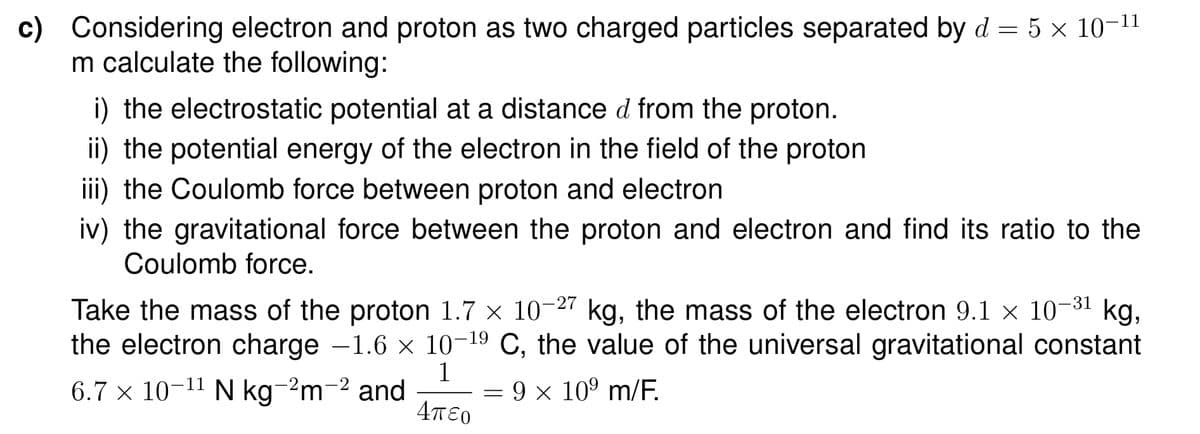O Considering electron and proton as two charged particles separated by d = 5 x 10-11 m calculate the following: i) the electrostatic potential at a distance d from the proton. ii) the potential energy of the electron in the field of the proton iii) the Coulomb force between proton and electron iv) the gravitational force between the proton and electron and find its ratio to the Coulomb force. Take the mass of the proton 1.7 x 10-27 kg, the mass of the electron 9.1 × 10-31 kg, the electron charge -1.6 x 10-19 C, the value of the universal gravitational constant 1 = 9 x 109 m/F. 4TE0 6.7 x 10-11 N kg-2m-2 and
O Considering electron and proton as two charged particles separated by d = 5 x 10-11 m calculate the following: i) the electrostatic potential at a distance d from the proton. ii) the potential energy of the electron in the field of the proton iii) the Coulomb force between proton and electron iv) the gravitational force between the proton and electron and find its ratio to the Coulomb force. Take the mass of the proton 1.7 x 10-27 kg, the mass of the electron 9.1 × 10-31 kg, the electron charge -1.6 x 10-19 C, the value of the universal gravitational constant 1 = 9 x 109 m/F. 4TE0 6.7 x 10-11 N kg-2m-2 and
Physics for Scientists and Engineers, Technology Update (No access codes included)
9th Edition
ISBN:9781305116399
Author:Raymond A. Serway, John W. Jewett
Publisher:Raymond A. Serway, John W. Jewett
Chapter23: Electric Fields
Section: Chapter Questions
Problem 23.28P: Consider n equal positively charged particles each of magnitude Q/n placed symmetrically around a...
Related questions
Question

Transcribed Image Text:c)
Considering electron and proton as two charged particles separated by d = 5 × 10-11
m calculate the following:
i) the electrostatic potential at a distance d from the proton.
ii) the potential energy of the electron in the field of the proton
iii) the Coulomb force between proton and electron
iv) the gravitational force between the proton and electron and find its ratio to the
Coulomb force.
Take the mass of the proton 1.7 x 10-27 kg, the mass of the electron 9.1 x 10-31
kg,
the electron charge -1.6 x 10-19 C, the value of the universal gravitational constant
1
6.7 × 10-11 N kg-2m-2 and
Απο
9 x 10° m/F.
Expert Solution
This question has been solved!
Explore an expertly crafted, step-by-step solution for a thorough understanding of key concepts.
This is a popular solution!
Trending now
This is a popular solution!
Step by step
Solved in 2 steps with 3 images

Knowledge Booster
Learn more about
Need a deep-dive on the concept behind this application? Look no further. Learn more about this topic, physics and related others by exploring similar questions and additional content below.Recommended textbooks for you

Physics for Scientists and Engineers, Technology …
Physics
ISBN:
9781305116399
Author:
Raymond A. Serway, John W. Jewett
Publisher:
Cengage Learning

College Physics
Physics
ISBN:
9781305952300
Author:
Raymond A. Serway, Chris Vuille
Publisher:
Cengage Learning

College Physics
Physics
ISBN:
9781285737027
Author:
Raymond A. Serway, Chris Vuille
Publisher:
Cengage Learning

Physics for Scientists and Engineers, Technology …
Physics
ISBN:
9781305116399
Author:
Raymond A. Serway, John W. Jewett
Publisher:
Cengage Learning

College Physics
Physics
ISBN:
9781305952300
Author:
Raymond A. Serway, Chris Vuille
Publisher:
Cengage Learning

College Physics
Physics
ISBN:
9781285737027
Author:
Raymond A. Serway, Chris Vuille
Publisher:
Cengage Learning

Physics for Scientists and Engineers with Modern …
Physics
ISBN:
9781337553292
Author:
Raymond A. Serway, John W. Jewett
Publisher:
Cengage Learning

Physics for Scientists and Engineers
Physics
ISBN:
9781337553278
Author:
Raymond A. Serway, John W. Jewett
Publisher:
Cengage Learning

Principles of Physics: A Calculus-Based Text
Physics
ISBN:
9781133104261
Author:
Raymond A. Serway, John W. Jewett
Publisher:
Cengage Learning